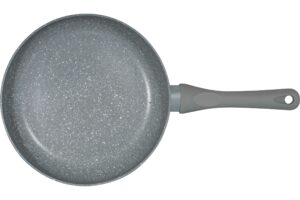How To Clean Ceramic Cookware: Expert Tips!
Introduction
Cleaning ceramic cookware doesn’t have to be hard. I’ve struggled with stubborn stains and burnt spots too. At first, I wasn’t sure how to clean ceramic pans without damaging them. But after lots of trial and error, I found simple ways that work. Whether you need to remove stains or keep your cookware looking new, I’ve got you covered. I’ll share easy steps to help you clean ceramic pots and pans the right way. No harsh scrubbing, no damage—just a quick and simple routine that keeps your cookware spotless!
Understanding Ceramic Cookware

Ceramic cookware stands out with its smooth, non-stick coating. It has a clay base with a slick glaze on top. This makes it safer than other non-stick pans. Ceramic pans don’t leak bad stuff when they get hot.
Why does food stick to your ceramic pan? It’s from oils that build up day by day. These oils form a sticky film that grabs your food. The fix is easy: clean well after each use to stop this film.
Taking care of ceramic pans is not hard, but you must do it right. Cold pans can crack if you put hot water on them. Rough pads can scratch the top. Once the coating gets hurt, food sticks more. This is why soft cleaning keeps ceramic pans working well.
I found this out the hard way with my first ceramic pan. I used steel wool on it after I burned rice. Soon after, eggs stuck like glue! Now I know how to treat my pans right. With good care, ceramic pans can stay non-stick for many years.
Daily Cleaning Routine for Ceramic Cookware
Cleaning ceramic cookware doesn’t have to be a chore. With the right steps, you can keep your pans spotless without scrubbing too hard. I learned this the hard way after ruining my first ceramic pan. Now, I follow a simple daily routine that keeps my cookware looking brand new.
1. Cool Before Cleaning
Never clean a hot ceramic pan. Sudden temperature changes can cause cracks. Let your pan cool naturally before washing it. This simple step prevents damage and extends its lifespan. If you’ve ever heard a pan make a popping sound after rinsing it with cold water—yep, that’s thermal shock! I made this mistake once and saw tiny cracks appear overnight.
2. Hand-Wash Only

Dishwashers might seem convenient, but they can strip the non-stick coating. Always wash ceramic cookware by hand. Use warm water and mild dish soap to clean without causing wear. A dishwasher’s heat and harsh detergent can ruin the glaze over time. I learned this when my once-smooth pan turned rough after just a few cycles.
3. Use the Right Tools

Soft sponges or cloths work best. Steel wool and abrasive pads might scratch the surface, so avoid using them. My go-to is a silicone scrubber—it removes food bits without harming the pan. If you’ve been using a regular sponge, make sure it’s non-abrasive. A gentle touch goes a long way!
4. Remove Stuck-On Food Gently

If food sticks, don’t scrape it off. Instead, soak the pan in warm, soapy water for 10-15 minutes. This softens any residue, making it easy to wipe away. For stubborn bits, sprinkle baking soda on the surface and gently rub with a soft sponge. I once scratched a pan by using a metal spoon—never again!
5. Dry Completely

After washing, dry your cookware with a soft towel. Letting water sit can cause stains or mineral buildup. I once left my pan to air-dry, and it developed white spots. Now, I always wipe it down to keep it looking new.
6. Store Properly

Stacking ceramic pans can lead to scratches. Place a soft cloth or paper towel between them if you need to stack. If you have space, store them separately. This keeps the coating intact and prevents chipping.
Why This Routine Works
By following these steps, you can keep your ceramic cookware in top shape. Even though it just takes a few minutes, the difference is significant. I used to replace my pans every year—now, they last much longer. With a little care, your ceramic cookware can stay non-stick and beautiful for years to come!
How to Deep Clean Ceramic Cookware
Even with the best daily care, ceramic cookware can still get stains, burnt food, or discoloration. I’ve been there—scrubbing away, wondering if my favorite pan was ruined. But don’t worry! Deep cleaning ceramic cookware is easier than you think. Here are simple methods to restore your pans without harsh chemicals or endless scrubbing.
Removing Burnt Residue
We’ve all had those moments when food sticks and burns. The good news? You don’t have to throw your pan away. Try these easy fixes:
Method 1: Lemon and Water Boil
Lemon works like magic! The acid breaks down burnt food and leaves your pan fresh.
- Fill the pan with water, covering the burnt areas.
- Cut a lemon into quarters and squeeze the juice into the water. Toss in the peels too!
- After bringing to a boil, simmer for five minutes.
- After turning off the heat, leave it alone.
- Wipe away the loosened residue with a soft sponge.
Why it works: The citric acid loosens burnt food without harsh scrubbing.
Method 2: Baking Soda & Vinegar Soak
Baking soda and vinegar create a fizzy reaction that lifts grime easily.
- Sprinkle baking soda over the burnt area.
- Pour white vinegar on top and watch it bubble.
- Let it sit for 15-20 minutes.
- Wipe with a soft sponge.
- Rinse and dry completely.
Why it works: Baking soda is gentle but effective, while vinegar dissolves tough stains.
Method 3: Hydrogen Peroxide Paste (For Stubborn Stains)
When nothing else works, this method saves the day!
- To form a paste, mix hydrogen peroxide and baking soda.
- After applying it to the stain, wait ten to fifteen minutes.
- Gently scrub with a soft sponge.
- Rinse well and dry.
Why it works: Hydrogen peroxide breaks down tough stains while disinfecting.
Removing Stains from Ceramic Cookware
Even if your pan isn’t burnt, stains can build up over time. Here’s how to fix it:
- For light stains: Sprinkle baking soda on a damp sponge and scrub gently.
- For deeper stains: Make a baking soda paste, apply, and let it sit for 30 minutes before wiping clean.
- For oil stains: Soak in equal parts vinegar and water for 10 minutes, then rinse.
Pro tip: Always dry your cookware right after washing to prevent water spots.
Tackling Stubborn Stains on Ceramic Cookware
For discoloration, mineral buildup, or tough spots, try these tricks:
- Use Bar Keeper’s Friend: This gentle cleaner works wonders on ceramic.
- Try a Magic Eraser: A damp Magic Eraser can buff away stains.
- For water spots and buildup: Soak in equal parts vinegar and water for 10 minutes, then wipe clean.
Cleaning Different Types of Ceramic Cookware
Different ceramic cookware needs different care. Here’s what works best:
- Non-stick ceramic pans: Use soft sponges and mild soap. Avoid metal utensils.
- Ceramic frying pans: Don’t use high heat, and clean with baking soda and vinegar when needed.
- Ceramic Dutch ovens: Avoid steel wool. Use a baking soda paste instead.
- Enameled cast iron: Stick to mild dish soap and soft sponges to protect the coating.
Keeping Your Ceramic Cookware Looking New
- Use wooden or silicone utensils. Metal can scratch the coating.
- Avoid sudden temperature changes. Let your pan cool before washing.
- Store properly. Place a soft cloth between stacked pans to prevent scratches.
- Use mild cleaners. Harsh chemicals damage the coating over time.
By following these simple deep-cleaning methods, your ceramic cookware will stay spotless and last for years. Have any favorite cleaning hacks? Share them in the comments—I’d love to hear your tips!
Special Care for Popular Ceramic Cookware Brands
Not all ceramic cookware is the same. Different brands have their own quirks. Knowing how to clean them can save you from frustration. I learned this the hard way—scrubbing a GreenPan too hard or using the wrong cleaner on my Zwilling skillet. If you want your cookware to stay like new, here’s how to care for popular brands.
How to Clean GreenPan Cookware
GreenPan is loved for its non-toxic, non-stick coating. But that coating needs gentle care.
Quick answer: Wash GreenPan by hand with warm water, mild soap, and a soft sponge. Avoid metal utensils, abrasive cleaners, and dishwashers.
- Keep the heat low: High heat can damage the non-stick surface.
- Skip cooking sprays: They leave a sticky residue that makes food stick over time.
- For burnt food: Fill the pan with warm water and a splash of vinegar. After 15 minutes of sitting, wipe it clean.
- Stubborn stains? A baking soda paste works wonders! Apply, let it sit, then wipe gently.
Cleaning Zwilling Ceramic Cookware
Zwilling’s ceramic cookware is tough but needs care to prevent scratches and stains.
Quick answer: Hand-wash Zwilling ceramic pans with mild soap and a soft sponge. Avoid stacking them without protection.
- Protect the surface: Never use steel wool or harsh scouring pads. Even tiny scratches can ruin the non-stick layer.
- Fix discoloration: If your white ceramic pan turns yellow, mix baking soda and water into a paste. Rinse after ten minutes of sitting.
- Handle with care: Avoid sudden temperature changes, like rinsing a hot pan with cold water, to prevent cracks.
Maintaining Tramontina Ceramic Cookware
Tramontina ceramic pans heat evenly and have a smooth finish, but they need delicate handling.
Quick answer: Clean Tramontina ceramic cookware with mild soap, warm water, and a soft cloth. Dry immediately to prevent stains.
- Don’t soak for too long: Too much water exposure can weaken the ceramic coating.
- Tackle tough stains: Mix equal parts baking soda and vinegar. After applying and letting it sit for ten minutes, wipe it off.
- Store properly: Place paper towels or pan protectors between stacked cookware to prevent scratches.
Caring for White Ceramic Cookware
White ceramic cookware looks beautiful, but stains show up fast. Keeping it clean takes a little extra effort.
Quick answer: Use baking soda, vinegar, or hydrogen peroxide to remove stains from white ceramic cookware.
- Wash right away: Cleaning immediately helps prevent stains from setting.
- For discoloration: Make a paste with hydrogen peroxide and baking soda. Apply, let it sit, then rinse.
- Water spots? Wipe with a vinegar-soaked cloth to restore shine.
Final Thoughts
Taking care of ceramic cookware isn’t hard. Each brand has its own needs, but the golden rule is always the same: be gentle. Avoid abrasive cleaners, high heat, and dishwashers, and your cookware will last for years.
Have a favorite cleaning hack for your ceramic cookware? Share it in the comments—I’d love to hear your tips!
Preventing Damage and Maintaining Ceramic Cookware
Keeping ceramic cookware in top shape doesn’t have to be complicated. I’ve learned through trial and error that small habits make a big difference. If you treat your ceramic pans right, they’ll stay non-stick, beautiful, and last for years. Here’s how to prevent damage and maintain their quality effortlessly.
1. Avoid High Heat
Ceramic cookware doesn’t need high heat to cook efficiently. Medium or low heat is best. I used to crank up the heat for a quick sear, but I noticed my pan’s coating started wearing out faster. Turns out, overheating can cause the non-stick surface to degrade over time.
Quick Tip: Stick to medium heat for cooking and only use high heat for short bursts when necessary.
2. Use the Right Cooking Utensils
Metal utensils are a big no-no for ceramic cookware. They scratch the surface and ruin the non-stick coating. I once used a metal spatula out of habit and ended up with tiny scratches that made my pan lose its slickness.
Better Option: Use wooden, silicone, or nylon utensils to keep your cookware scratch-free.
3. Avoid Cooking Sprays
Cooking sprays seem harmless, but they leave behind a sticky residue that builds up over time. This can create a rough surface that makes food stick more.
Best Alternative: Use a small amount of high-smoke-point oils like avocado or coconut oil, and apply them with a brush or paper towel.
4. Let Your Cookware Cool Before Cleaning
Rinsing a hot ceramic pan under cold water might seem like a quick way to clean it, but it can cause thermal shock, leading to cracks. I made this mistake once, and my pan developed tiny fractures overnight.
Pro Tip: Always let your pan cool naturally before washing it.
5. Wash by Hand
Dishwashers can be rough on ceramic cookware. The high heat and strong detergents wear down the non-stick coating.
Simple Fix: Hand-wash your pans with warm water, mild soap, and a soft sponge. It only takes a minute and keeps your cookware in great shape.
6. Choose the Right Cleaning Tools
Abrasive scrubbers, steel wool, and harsh scouring pads can damage ceramic cookware fast. I once used a rough pad to scrub off a stain and ended up making things worse.
Best Choice: Use soft sponges, microfiber cloths, or silicone scrubbers to clean without scratching.
7. Store Properly to Prevent Scratches
Stacking ceramic pans can lead to scratches and chips. If you don’t have much storage space, layer soft cloths or paper towels between them.
Storage Hack: Hang your pans or place a protective pad between stacked cookware to keep the coating intact.
8. Keep the Exterior Clean
The bottom of ceramic cookware can get stained over time from heat and spills. To keep them looking new, wipe the exterior regularly with a damp cloth. A baking soda paste can work wonders on harder stains.
Easy Fix: Mix baking soda and water into a paste, apply it to the stained area, let it sit for 10 minutes, and then wipe clean.
9. Avoid Long Soaks
Leaving ceramic cookware soaking in water for too long can weaken the glaze and lead to discoloration. If food is stuck, a short soak (10–15 minutes) with warm water and baking soda is all you need.
Better Solution: Soak briefly, then scrub gently with a non-abrasive sponge.
Final Thoughts
Caring for ceramic cookware is simple when you follow these easy steps. Avoid high heat, use gentle tools, and wash by hand to keep your cookware looking and performing like new. I’ve seen firsthand how a little extra care can make ceramic pans last for years. Got your own ceramic cookware tips? Tell me what works for you by sharing them in the comments section!
FAQs: How to Clean Ceramic Cookware
1. How do you clean ceramic cookware?
Wash with warm water and mild soap. Use a soft sponge to avoid scratching. For tough stains, soak with baking soda and vinegar.
2. How to clean a burnt ceramic pan?
Sprinkle baking soda over burnt areas. After adding water, wait fifteen minutes. Use a sponge to gently scrub, then rinse.
3. How to clean ceramic pots and pans?
Hand-wash with a mild detergent. Avoid metal utensils and abrasive cleaners. Rinse and dry completely to prevent stains.
4. How to clean a ceramic frying pan?
Let the pan cool before washing. Use a soft sponge, dish soap, and warm water. Soak in water and baking soda for food that has become trapped.
5. How may stains be eliminated from a ceramic pan?
To make a paste, combine baking soda and water. After applying it on stains, wait ten minutes.
6. How to clean a ceramic Dutch oven?
Soak with warm water and baking soda. Scrub with a soft brush. Avoid harsh scouring pads to protect the surface.
7. How to clean a GreenPan?
Hand-wash with mild soap and a non-abrasive sponge. For stains, use baking soda and water. Avoid high heat when cooking.
8. How to clean enameled cast iron cookware?
Use warm water and dish soap. Use a mixture made of baking soda and water to scrub away tough stains.
9. How to clean a burnt GreenPan?
Fill with water and a splash of vinegar. Heat until simmering, then let cool. Wipe with a sponge to remove residue.
10. How to keep ceramic cookware clean?
Wash after each use. Avoid high heat, metal utensils, and harsh cleaners. Dry completely before storing.
Conclusion
Cleaning ceramic cookware is easy. When I got my first ceramic pan, I thought it would stay non-stick forever. But after months of daily use, food started sticking, stains appeared, and the smooth surface lost its shine. I scrubbed harder—big mistake. Then I learned the right way to clean it, and everything changed.
Quick answer: Wash by hand, use gentle cleaners, avoid high heat, and store properly to keep ceramic cookware clean and long-lasting.
If you’ve dealt with burnt residue, tough stains, or discoloration, you’re not alone. The good news? The fixes are simple. Baking soda, vinegar, or a lemon can work wonders. And small habits—like letting your pan cool before washing and using a soft sponge—help keep your cookware in great shape.
Key takeaway: The right care keeps ceramic cookware non-stick, stain-free, and long-lasting.
The best thing about ceramic cookware is how easy it is to maintain once you know how. No more endless scrubbing or worrying about damage. A quick rinse, a soft sponge, and an occasional deep clean keep your pans looking like new.
Final tip: Treat your ceramic cookware well, and it will make cooking and cleaning easy.
I’ve learned these tips through trial and error, and now my ceramic cookware lasts much longer. Do you have any favorite cleaning tricks? Share them in the comments so we can all keep our cookware in top shape!
To Know more about Simple 6 Secrets: How To Clean A Cast Iron Dutch Oven, Please visit our Blogs section
External Source for more info



Nice review